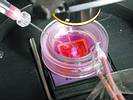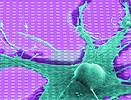Neurological biosensor chip directly measures electrical activity in living cells
12 March 2003
News
Infineon Technologies and the Max Planck Institute have jointly described how they directly connected a newly developed biosensor chip with living nerve cells to read electrical signals produced by the cells. The ‘Neuro-Chip’ development was described in a paper presented at the recent international solid-state circuits conference (ISSCC).
Neurons are the specialised cells that make up the nervous systems of all living things. Nerve tissues, comprised of many associated nerve cells, are the principal component of the brain and spinal cord. Nerve cells communicate with each other through electrical pulses, so the ability to read these signals and record them in a computer system holds the promise of new insights into neurological processes.
"Concerning the signal-to-noise ratio this chip operates close to elementary physical limits," said Dr Roland Thewes, the senior director responsible for biosensor chip activities within the corporate research centre at Infineon Technologies. "Infineon is able to draw on 50 years of knowledge in chip making to develop biochips that bring the advantages of silicon technology to biochemistry and new drug research."
According to Infineon, the neuro-chip integrates 128 x 128 sensors in an array pattern covering one square millimetre. A sophisticated electronic circuit is integrated below each sensor, which amplifies and processes the extremely weak signals for transfer to a computer system for processing. Individual neurons are placed into a nutrient solution above the sensor array, which keeps the neurons alive. Infineon says that the sensor density is approximately 300 times greater than today's common methods for studying neurons, which use glass substrates with vapour-deposited metallic lanes to contact the neuron. Each sensor on the chip is separated by a distance of just eight microns. Typical size of neurons is between 10-50 mm.
The neuro-chip’s sensor grid is 1 x 1 mm. The integrated circuitry enables it to record, amplify and process the more than 32 million information bytes per second that are delivered by the 16 384 sensors on the grid
Instead of sequentially checking every single neuron, the neuro-chip surveys several neurons at the same time, which gives more statistically relevant data. Additionally, the chip enables recording of the operating sequence of electrical activity within nerve tissue over a defined time. Every second, it can record more than 2000 single values for each of its 16384 sensors. The data can then be transformed into a colour picture for visual analysis. Researchers can detect from this data how complete nerve tissues react to electrical stimulation or certain chemical substances in a given period of time.
A living nerve cell connected to the neuro-chip. The typical size of neurons is between 10–50 mm
Infineon says that the chip is based on a standard CMOS technology extended with additional process steps to realise the capacitive sensors array. Total area measures 5 x 6 mm, including the circuitry required to amplify, process, and transmit the data off-chip. The neuro-chips can detect and handle voltage changes with peaks ranging from 100 µV to 5 mV.
For more information see www.infineon.com
Further reading:
From the editor’s desk: Windows 10’s end of support arrives bringing industrial risks
Technews Publishing
News
By the time you read this column, support for non-LTSC editions of Windows 10 will have ended, officially having their last day on 14 October 2025. This means no more security patches, feature updates,
...
Read more...
Electronic News Digest
News
A brief synopsis of current global news relating to the electronic engineering fields with regards to company finances, general company news, and engineering technologies.
Read more...
Correction: Marijana Abt, Rebound Electronics
News
In the August issue of
Dataweek magazine, the article titled ‘Celebrating innovation, leadership, and the next generation’ featured Marijana Abt, senior account manager at Rebound Electronics. Owing
...
Read more...
Trasna and RF Design announce distribution agreement
RF Design
News
Trasna and RF Design have announced a strategic distribution agreement for cellular IoT solutions which will ensure seamless availability of Trasna’s cellular connectivity solutions.
Read more...
Local partnership puts demand-side management to work in South Africa
News
Sensor Networks has partnered with European demand-side management specialist ThermoVault to bring advanced load-shifting capabilities to one of the country’s biggest energy consumers: the household geyser.
Read more...
Hisense SA launches year-long learnership programme for youth
News
Hisense SA’s manufacturing plant in Atlantis recently welcomed 100 young people from the local community, to embark on a year-long learnership and skills development programme.
Read more...
Comtest hosts channel partners
Comtest
News
Comtest, together with FLUKE, recently set the stage for an unforgettable afternoon as they welcomed over 80 Channel Partners to their annual celebration of excellence.
Read more...
RS South Africa and Qhubeka empower learners through the gift of mobility
RS South Africa
News
Through its bicycle donation initiative, 354 bicycles have been distributed to date, empowering students to access education more easily by reducing the physical and economic barriers posed by long daily commutes.
Read more...
Deca and SST announce strategic collaboration
News
The collaboration provides customers with a modular, memory-centric foundation for advanced multi-die architectures.
Read more...
Specialised Exhibitions transitions to new name: Montgomery Group Africa
News
As part of a strategic move to streamline operations, strengthen regional alignment, and support long-term growth, Specialised Exhibitions has transitioned to a new name: Montgomery Group Africa.
Read more...



